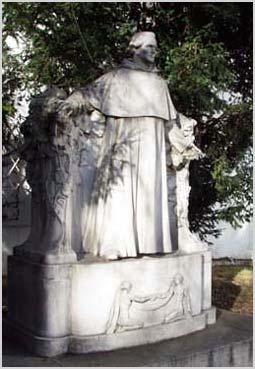Gregor (Johann) Mendel
Botanist and monk, b. 22 July1822 (Heinzendorf, Austria), d. 6 January 1884 (Brünn, Austria-Hungary [today's Brno, Czech Republic]).
 Johann Mendel came from a peasant family. He showed an early interest in and gift for natural science. His parents could not afford him a good education and decided that his best opportunity to develop his talents would be through the church. After two years of study at the Philosophical Institute al Olmütz (today's Olomouc) Mendel thus entered the Augustine order of monks in 1843 and joined its monastery at Brünn in Moravia (today's Brno in the Czech Republic), taking the name Gregor.
Johann Mendel came from a peasant family. He showed an early interest in and gift for natural science. His parents could not afford him a good education and decided that his best opportunity to develop his talents would be through the church. After two years of study at the Philosophical Institute al Olmütz (today's Olomouc) Mendel thus entered the Augustine order of monks in 1843 and joined its monastery at Brünn in Moravia (today's Brno in the Czech Republic), taking the name Gregor.
During the following years Mendel studied by himself. He was ordained a priest in 1847. He worked as a substitute teacher and tried to pass the teachers' examination but failed. In 1851 his abbot, recognizing his abilities, then sent him to the University of Vienna, where Mendel studied physics, chemistry, mathematics and biology.
After his return to his monastery in 1854 Mendel worked as a teacher for natural science in the technical high school of Brünn until 1868, when he was elected abbot. He spent the remaining years of his life occupied with the monastery's administration, arguments with the state authorities about taxation and similar issues.
During the years 1856 - 1868 Mendel performed experiments with plants that revolutionized biology and laid the groundwork for the modern understanding of biological inheritance. Mendel was interested in the process involved in plant breeding, a millennia-old practice that was until then entirely based on empiricism. He obtained seven varieties of the garden pea (Pisum sativum) from cultivations. The garden pea is self-pollinating, so the seven varieties were pure in their specific traits (round or wrinkled seed, green or yellow seed, white or purple flowers etc.). Mendel manually cross-pollinated the varieties to produce several generations of hybrids and observed how the specific traits were transferred from generation to generation.
Mendel presented the results of his experiments to the Natural Science Society of Brünn in 1865 and published them as Versuche čber Pflanzen-hybriden ("Experiments with Plant Hybrids") in its transactions in 1866. The biologists of the time could not follow his mathematical arguments, and his work was forgotten for 34 years. In 1900 three botanists in Switzerland, Germany and Austria discovered Mendel's Law independently and nearly simultaneously and, on going through the literature, rediscovered his paper. It was translated into English in the same year.
References
Dunn, L. C. (1995) Gregor (Johann) Mendel, Encyclopaedia Britannica 15th ed.
Abbey of St Thomas, Brno, Czech Republic Mendel Museum of Genetics, http://www.mendel-museum.org/eng/1online/ (accessed 23 April 2004).

Mendel statue (circa 1910) in garden of the Abbey of St Thomas, Brno, Czech Republic.
home
 Johann Mendel came from a peasant family. He showed an early interest in and gift for natural science. His parents could not afford him a good education and decided that his best opportunity to develop his talents would be through the church. After two years of study at the Philosophical Institute al Olmütz (today's Olomouc) Mendel thus entered the Augustine order of monks in 1843 and joined its monastery at Brünn in Moravia (today's Brno in the Czech Republic), taking the name Gregor.
Johann Mendel came from a peasant family. He showed an early interest in and gift for natural science. His parents could not afford him a good education and decided that his best opportunity to develop his talents would be through the church. After two years of study at the Philosophical Institute al Olmütz (today's Olomouc) Mendel thus entered the Augustine order of monks in 1843 and joined its monastery at Brünn in Moravia (today's Brno in the Czech Republic), taking the name Gregor.